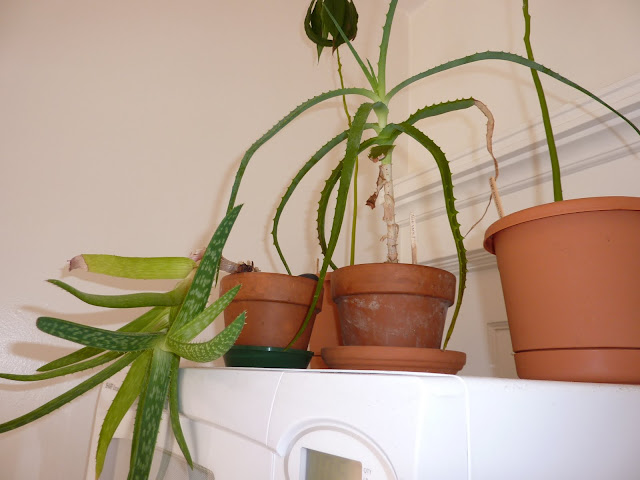I just realized that for whatever reason I'm growing both the smallest and largest citrus fruits. Both kumquats and pomelos are members of the rue family (citrus family), Rutaceae. The pomelo is a member of the genus
Citrus; while kumquats are
Fortunella, although this is currently under debate.
Citrus comes from the Greek word for the citron tree (
Citrus medica).
Fortunella is named after Robert Fortune, a Scotsman that introduced the fruit to Europe. Kumquat, by the way, is just an Anglicization of the Cantonese name for the fruit that basically means golden orange (
quat in loquat also refers to the orange).

Here is a photo of my two little kumquat trees. One has a yellow fungus growing in its soil. If you haven't had a kumquat, they are interesting little fruits. You eat the whole thing, rind and all. The inside is very tart and the skin is sweet. My parents have a large kumquat tree in their yard (this is where I get my seeds). I had a lot of fun throwing kumquats at things (people, bee hives, cats) as a kid, and for many years have had the dream of growing a little fruiting kumquat tree in a pot. Unfortunately I have no orange thumb when it comes to kumquats. These two are pitiful, but hopefully they'll survive.

In my jungle, Goliath is beating David. This is my grove of pomelos. I hadn't tried a pomelo until last year when the grocery store around the corner had one in the discount box. They are great. I like them much more than grapefruits. Pomelos are less sour and obviously much larger than grapefruits; although the actual edible part is deceptively smaller than one might think. We bought an organic pomelo at the Alemany Farmers' Market and it had more seeds than I knew what to do with. Since I'm not very successful with citrus seeds I planted all of them. Unfortunately almost all of them sprouted. I gave MANY away but still have a dozen or so. They also started growing out of pots I didn't know they were in. I really should stop recycling potting soil.

Here is a close up of the leaves of one of my pomelos. The pomelo leaves, much like the leaves of the Kaffir lime (
Citrus x hystrix, an unresolved hybrid), appear to be funky compound leaves where one leaf grows out of the apex of another. This isn't actually the case, as only the distal portion of this structure is the true leaf. The proximal portion is a modified petiole (Latin for little foot) called a phyllode (Greek for leaf-like). This odd adaptation is common in several
Acacia species.
Because I have so many of these things, I've been experimenting with them. I had several sprout that lacked chlorophyll--in the entire plant or in just the leaves. Those obviously did not last very long. Also some are placed by the kitchen window where they are exposed to a constant draft and chilly temperatures in the middle to upper 40s F at night. Those have shown signs of stress or died. The best looking pomelos have been grown in indirect sunlight at room temperature. If enough of these make it past a year or two, I may attempt to graft kumquats onto them.
 My wife has been growing this spiky little Star for about five or six years. The shell is from Hawaii (nerdy irony: Honolulu is antipodal to southern Africa). We repotted it three years ago and it has almost doubled in size since then. I should have taken a photo before it dropped its leaves around New Year's Day. Right now it looks like a cross between a cucumber and a voodoo doll. We thought that something was wrong with it when leaves started to shed, but apparently it is deciduous so that is normal. It has yet to flower. I just recently read that to make it flower, one shouldn't water it during the dormancy period; so from now on it is on the wagon. A few weeks ago I noticed several flowering Pachypodia in a nearby tailor's shop. I'll use my spy skills and get a stealth photo of her plants soon. I may even try to liberate one...
My wife has been growing this spiky little Star for about five or six years. The shell is from Hawaii (nerdy irony: Honolulu is antipodal to southern Africa). We repotted it three years ago and it has almost doubled in size since then. I should have taken a photo before it dropped its leaves around New Year's Day. Right now it looks like a cross between a cucumber and a voodoo doll. We thought that something was wrong with it when leaves started to shed, but apparently it is deciduous so that is normal. It has yet to flower. I just recently read that to make it flower, one shouldn't water it during the dormancy period; so from now on it is on the wagon. A few weeks ago I noticed several flowering Pachypodia in a nearby tailor's shop. I'll use my spy skills and get a stealth photo of her plants soon. I may even try to liberate one...



















